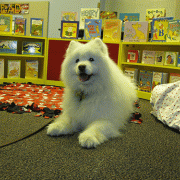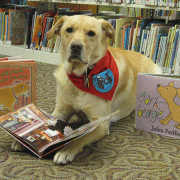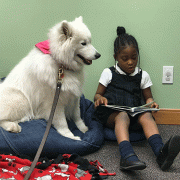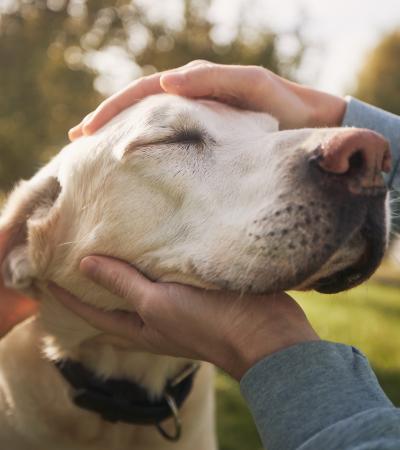Read to a Dog at Shaker Library is an ongoing opportunity for young readers to read to a certified therapy dog. The program is offered on the third Thursday of every month from 4 to 5:30 p.m. and has been running since 2010.
Advanced Planning
I had read about libraries using dogs to promote reading and was eager to try it at our library. My goal was to provide a safe, comforting, private space for a child (and family, if they desire) to read to a non-judgmental therapy dog to encourage the child’s reading skills, confidence and love of reading.
I was in the process of getting my own dog certified with Therapy Dogs International during this time, so I was learning about the program from the handler's point of view, as well. I recommend starting months in advance to get approval from library administration and to find a volunteer team of handlers and dogs.
Make sure your therapy dog team is certified with a reputable organization like Therapy Dogs International or Pet Partners. These organizations will put out the call to local volunteer handlers, and the volunteer handlers will get in touch. Both organizations require the dogs to pass a test verifying that they are friendly, well-behaved and up to date on all their shots. The organizations also carry insurance on their volunteers in the unlikely event of an incident.
Both the handler and dog should be well-suited to reading assistance — calm and patient. This is not reading instruction; the human handler only intervenes if a child asks a question such as, “What is that word?” It is helpful to have a few teams you can call on in case something comes up with either the human or the dog.
Beginning two weeks prior to the program, children can register for a 15-minute time slot.
Marketing
Read to a Dog is included in our online calendar and youth services program flier, which is available in the library and distributed to all the elementary schools in Shaker Heights. If registration is slow we create a small display to promote the program, but that rarely happens.
Budgeting
One of the many great things about this program is that it’s free! Both of the major organizations that certify therapy dogs prohibit the handlers from accepting money for their service. Shaker Library has been very fortunate in finding reliable and dedicated volunteer handlers.
The only potential costs would be when starting up the program, if a blanket or beanbag chair is desired for the reading area.
Day-of-event Activity
A couple days before the event I touch base with the therapy dog team to confirm the date and time.
On the day of the event we set up our program room with a cozy reading area. This includes a blanket and beanbag chair, as well as chairs for the dog handler and accompanying adults. Dog-themed books of various reading levels are displayed in the room. There are so many great dog-themed books out there, but a few of particular note would be:
- "Bark, George" by Jules Feiffer
- "Madeline Finn and the Library Dog" by Lisa Papp
- "May I Pet Your Dog?: The How-to Guide for Kids Meeting Dogs (and Dogs Meeting Kids)" by Stephanie Calmenso
- The Biscuit books by Alyssa Satin Capucilli
- The Henry and Mudge books by Cynthia Rylant
We hang a “Do not disturb. Reading in progress.” sign on the door during reading time. The handler and library staff at the desk help usher the readers in and out at their designated times. Only the reader, the reader's family/guardians, dog and handler are in the room. Our library has windows into the program room so the child is always visible to staff in case no family member is present in the room.
Readers receive a paw print handstamp and sometimes a bookmark or calling card from the dog team.
Make sure you have a bowl of water available for the dog.
Program Execution
Shaker Heights Public Library has offered Read to a Dog for more than eight years, and it is a consistently popular program with many favorable comments.
The majority of those who register for the program actually show up. When they do not, we have no trouble recruiting another reader. Attendees are enthusiastic, and many sign up repeatedly. Library staff also look forward to seeing the therapy dogs.
Advice
Based on attendance and customer comments we have found this program to be highly successful. We know that just petting a dog can reduce a person’s blood pressure and heart rate, and we know that children learn best when they feel relaxed and safe.
The calm presence of the dog helps us provide these optimal conditions for our young readers. Dogs are comforting and listen without correcting or judging. Children gain confidence and get excited about reading. Enthusiasm leads to practice, which leads to fluency.
There is novelty in reading to a dog rather than a person (and a dog does not criticize or correct). The dogs are the motivators, and they do an excellent job. Families who can’t have a dog of their own will sign up, as well as those whose child has a fear of dogs to help them overcome their fears. The benefits of this program have been many and varied.






